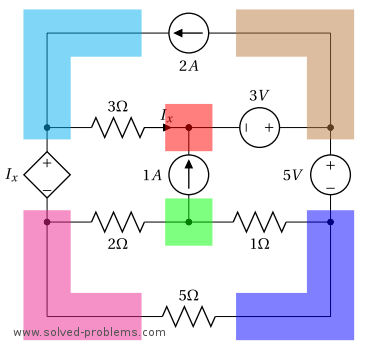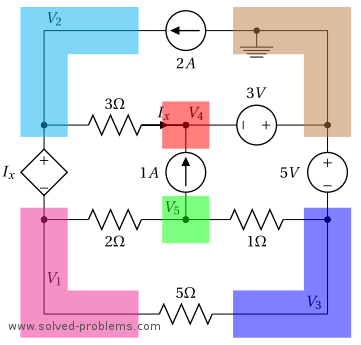
Determine the power of each source after solving the circuit by the nodal analysis.
Answers: ![]() and
and ![]()
Solution
I. Identify all nodes in the circuit.
The circuit has 6 nodes as highlighted below.

II. Select a reference node. Label this node with the reference (ground) symbol.
The right top node is connected to two voltage sources and has three elements. All other nodes also have three elements. Hence, we select the right top node because by this selection, we already know the node voltages of two other nodes, i.e. the ones that the reference node is connected to them by voltage sources.

III. Assign variables for unknown node voltages.
We label the remaining nodes as shown above. Nodes of ![]() and
and ![]() are connected to the reference node through voltage sources. Therefore,
are connected to the reference node through voltage sources. Therefore, ![]() and
and ![]() can be found easily by the voltages of the voltage sources. For
can be found easily by the voltages of the voltage sources. For ![]() , the negative terminal of the voltage source is connected to the node. Thus,
, the negative terminal of the voltage source is connected to the node. Thus, ![]() is equal to minus the source voltage,
is equal to minus the source voltage, ![]() . The same argument applies to
. The same argument applies to ![]() and
and ![]() .
.
IV. Incorporate dependent sources. If there are dependent sources in the circuit, write down equations that express their values in terms of node voltages.
The voltage of the dependent voltage source is ![]() . We should find this value in terms of the node voltages.
. We should find this value in terms of the node voltages. ![]() is the current of the
is the current of the ![]() – resistor. The voltage across the resistor is
– resistor. The voltage across the resistor is ![]() . We prefer to define
. We prefer to define ![]() as
as ![]() instead of
instead of ![]() to comply with passive sign convention. By defining
to comply with passive sign convention. By defining ![]() as mentioned,
as mentioned, ![]() is entering from the positive terminal of
is entering from the positive terminal of ![]() and we have
and we have ![]() . Therefore,
. Therefore, ![]() .
. ![]()
V. Apply Kirchhoff’s Current Law (KCL) / VI. Handle super-nodes.
Nodes of ![]() and
and ![]() :
:
These two nodes are connected through a voltage source. Therefore, they form a supernode and we can write the voltage of one in terms of the voltage of the other one. Please note that the voltage of the dependent voltage source is ![]() and we have
and we have ![]()
![]()
![]()

KCL for the supernode:![]()
![]()
![]()
![]()
Substituting ![]() ,
,![]()
Node of ![]() :
:![]()
![]()
Substituting ![]() and
and ![]() ,
,![]()
Here is the system of equations that we need to solve and obtain ![]() nd
nd ![]() :
:
![]()
VII. Solve the System of Equations.
We use elimination method to solve this system of equation:![]()
![]()
![]()
![]()
Using ![]() ,
,![]()
VIII. Determine Additional Variables.
All node voltages are determined. Now, the power of voltage sources can be calculated from the node voltages. For each source, we need to find the voltage across the source as well as the current flowing through it to compute the power.
![]() current source:
current source:
The voltage across the ![]() current source is equal to
current source is equal to ![]() . However, the comply with the passive voltage convention, the current should be entering from the positive terminal of the defined voltage as shown below. Therefore,
. However, the comply with the passive voltage convention, the current should be entering from the positive terminal of the defined voltage as shown below. Therefore, ![]() .
.
![]() absorbing power
absorbing power

![]() current source:
current source:
To compliant with the passive sign convention, the voltage ![]() should be defined with polarity as indicated above. We have
should be defined with polarity as indicated above. We have ![]() . Hence,
. Hence,
![]() supplying power.
supplying power.
![]() voltage source:
voltage source:
![]() should be defined such that it enters from the positive terminal of the source in order to use the voltage of the source in power calculation. Another option is to use
should be defined such that it enters from the positive terminal of the source in order to use the voltage of the source in power calculation. Another option is to use ![]() and define the current as entering from the voltage source terminal connected to the node of
and define the current as entering from the voltage source terminal connected to the node of ![]() . We use the first approach here. KCL should be applied in the node of
. We use the first approach here. KCL should be applied in the node of ![]() to determine
to determine ![]() .
.
KCL @ Node of ![]() :
:
![]()
![]()
![]() supplying power.
supplying power.
![]() voltage source:
voltage source:
Likewise, ![]() should be defined as shown above to comply with the passive sign convention. We apply KCL to the reference node to find
should be defined as shown above to comply with the passive sign convention. We apply KCL to the reference node to find ![]() .
.
KCL @ the reference node:
![]()
![]()
![]() supplying power.
supplying power.
The dependent source:
The voltage of the dependent source is ![]() and we define its current
and we define its current ![]() with the direction illustrated above.
with the direction illustrated above. ![]() can be calculated by applying KCL at the node of
can be calculated by applying KCL at the node of ![]() . The current of the
. The current of the ![]() resistor is
resistor is ![]() which is equal to
which is equal to ![]() .
.
KCL @ Node of ![]() :
:![]()
![]() absorbing power.
absorbing power.
Download the Circuit File
To download the LTspice circuit file for your own simulations, click the link below.Please remember to unzip the file after downloading to access the .asc file for your simulations:

Leave a Reply